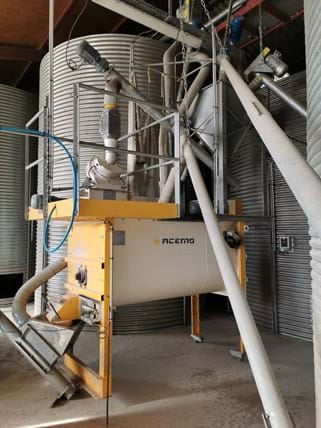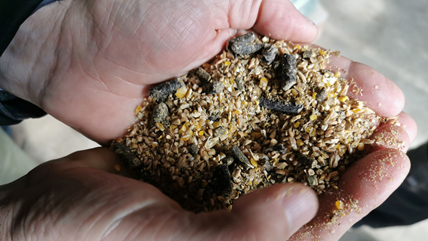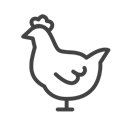
Since the end of 2015, the customer has been producing his own feed for beef cattle
With the on-farm feed production, we've gained what corresponds to one extra calf a month
Read what Sébastien LAGRAFEUIL, a breeder of 300 Limousine cattle in Corrèze, has to say. Since the end of 2015, he has been making his own feed to feed his beef cattle. He tells us how the outcome of the on-farm feed production project and what he has learned from his experience as an on-farm feed producer.
Why did you buy your own on-farm feed mill?
The aim of on-farm feed production is to provide fresh, uniform feed all year round for our animals, and then to better control the feed costs. Before, we used to buy feed, but it wasn't regular. A change of formula had consequences for the animals. And it's not a question of kilograms. An animal was not well. It was getting up and lying down. It had a stomach ache. The manure varied: One day it was solid, another day it was liquid. It was irregular because the feed was not homogeneous. Overall, the animals were stressed and losing growth.
Then my son and an employee joined us on the farm. So we took the plunge and went from 150 ha to 450 Ha, manufacturing feed for our animals
How long did the project take?
The technical sales representative for the sector, Joël Fabre (now retired), came along. The decision was made very quickly: Within 2-3 months. We were off and running! We put our trust in Joël, whom we had met in Paris at SIMA.

How do we work with on-farm feed production?
We want feed that is always fresh! We produce 400 to 450 kg batches of feed for a day or two, but that is it. The production does not take long because everything is automated. We clean it 2 or 3 times a year, grease it and that is it.
Since this year, we have been supported by a nutritionist who comes to the farm 4 times a year. He analyses the animals, takes our stock into account, makes and adjusts our recipes, monitors performance, advises us, etc.
As an example of his recommendation, he has advised us to use liquid proteins, which are integrated thanks to the oil pump and the spray nozzle on the mixer.
Today, we formulate 4 different rations:
- Beef cattle
- Breeding stock
- Heifers
- Calves
Since 2015, this farm has been producing its feed using an MSK compact feed mill, the heart of which consists of a SKIOLD Disc Mill, an H500 horizontal mixer with a capacity of 1,380 litres (i.e. 500 kg of feed) and a 320 litre grain hopper. Production is automated using a Fabristar control unit.
"With the Disc Mill, here we cut the grain to get clean, straight cuts. Sometimes the nutritionists call us to fine-tune the grain size of the rations. They are right, that is what we need to do! It is important to adapt the grain size according to the physiological stage of the animals", says Eric Manenc, SKIOLD Sales Manager.
What has the feed mill done for us?
Before, we had the pails outside, the shovel and the bucket. With the on-farm feed production, we have saved time and we work better.
Bovin Croissance follows us. In the first year, we gained between 20g and 80g GMQ per calf per day, with an average of 55g. We have 300 calves. Knowing that calves stay 10 months, we have gained what corresponds to 1 calf per month.
The feed efficiency is optimal.
As far as feed costs are concerned, it is difficult to talk about a price. How do you define the price of grains? The price that it costs us to produce it or the price I have to pay for it? These are two different things.
For us, the factory pays for itself and we are self-sufficient in grains.
What we have to do is try to economize every penny and every gram.
What is the secret to quality feed?
The grains, we pamper it. We clean it, we give it time, we ventilate it. That is the secret.
First of all, all my grain are grown after maize.
Then, all the cereals that come in are ventilated. There is no dust, there is nothing. Just the grain. The grain is clean. For this, why we have a dust aspirator! It is the best. There is no point in storing dust.
Eric points out that "the advantage of having a dust collector is that you remove the light particles and optimise ventilation".
Grain today is expensive. You have to take care of it.
To sum up, once the grains have been collected and placed in intake area, here is the secret to quality feed:
- Remove dust from the grains
- Ventilate the grains
- Automatic management of grain size

Any advice for other livestock farmers who want to invest in an on-farm feed mill?
Think carefully about the pre-cleaning and the intake section. That is a must! And make sure you have a high building to have height for storage.
Eric Manenc explains:
"We are being asked for large intake / storage section of 60 m3 with cyclonic pre-cleaners rather than cascade pre-cleaners. If the farmer does not want it, we always leave room for adding one later. And when it comes to storage, when the building can be high, the idea is to encourage high storage to reduce floor space and investment."
Installation made by SKIOLD France
Do you want to make your own cattle feed? Contact us to find out more about our customisable feed milling solutions:
CONTACT US FOR FURTHER INFORMATION
Farm information:
- Meilhards, Corréze, France
- Four partners, one employee and one apprentice
- Breeding of beef cattle: 300 Limousine cattle
- UAA: 450 Ha (including 15 Ha of various barley, 15 Ha of wheat and 12 Ha of grain maize - non-irrigated)
- Production of 500 tonnes of feed per year
- SKIOLD MSK on-farm feed mill: Disc Mill / 500 kgs horizontal mixer (H500) / Fabristar control unit - commissioned in 2015


 English
English
 Danish
Danish
 French
French
 Swedish
Swedish
 Vietnamese
Vietnamese
 Spanish
Spanish
 German
German
 English
English




